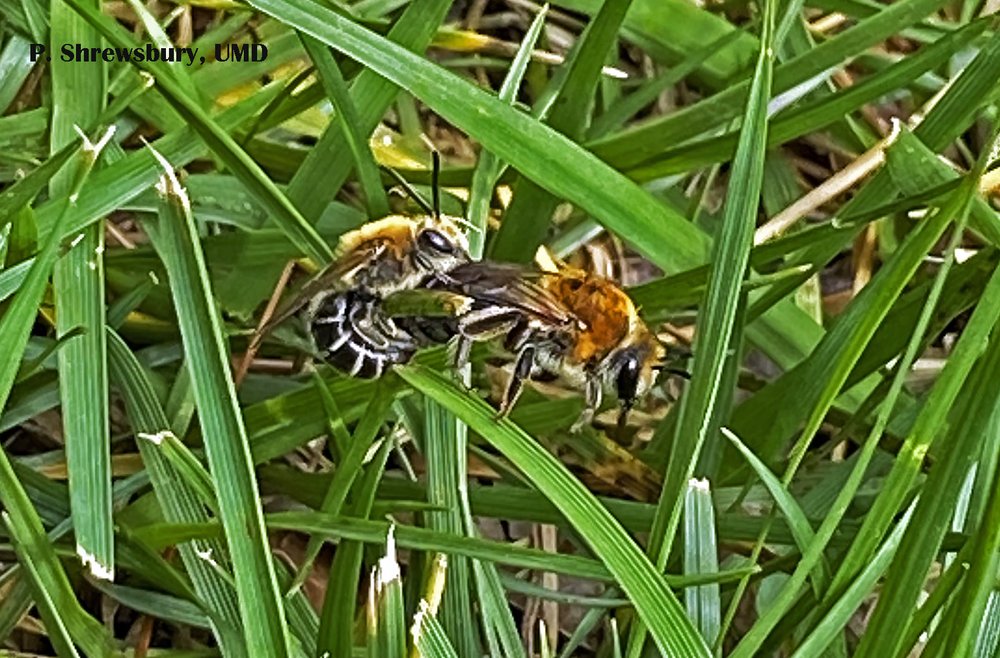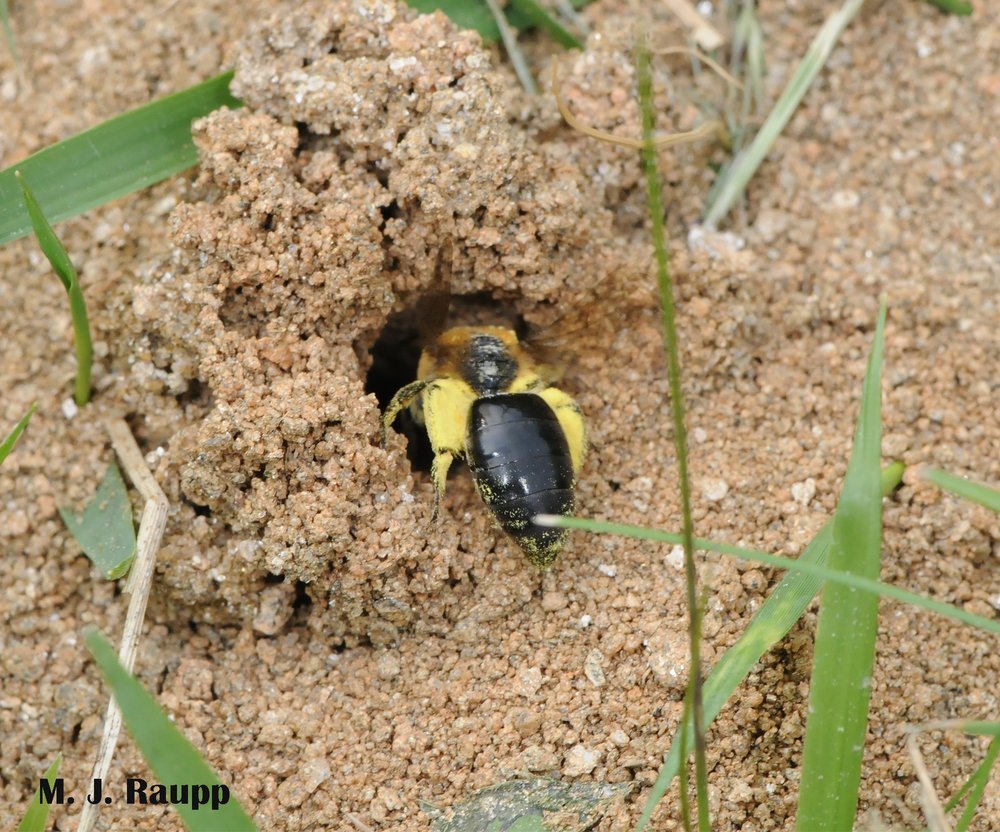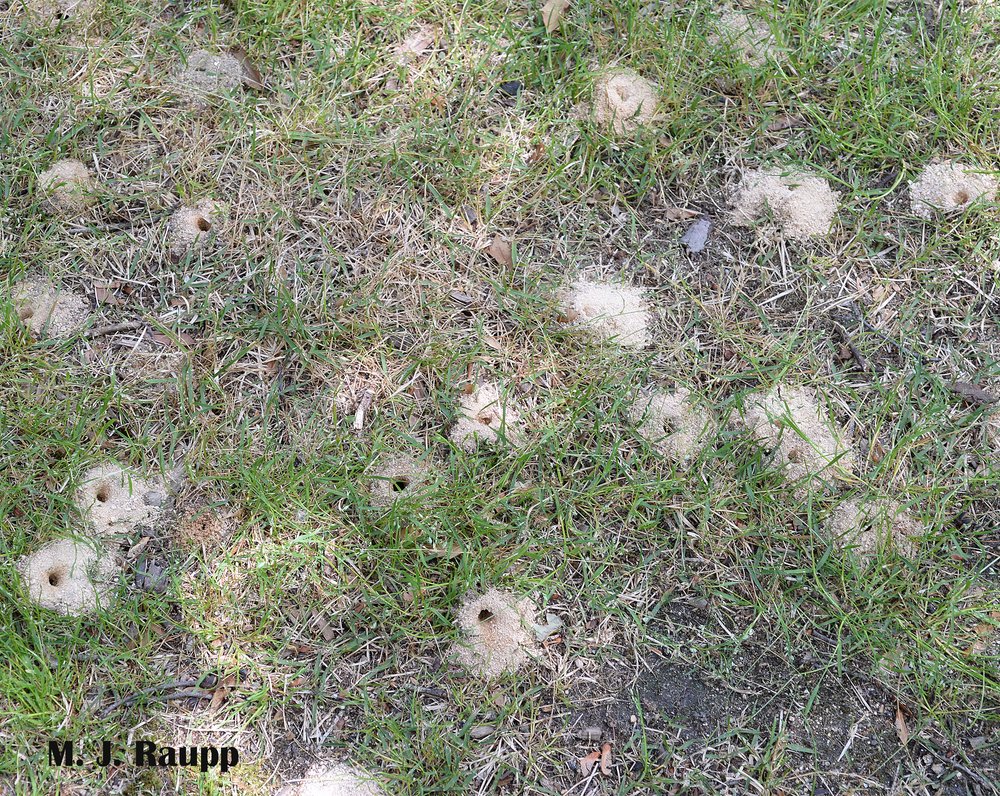Boisterous bee-havior of ground nesting bees, Colletes thoracicus

Splendor in the grass as one lucky suitor finds his mate (male on left, female on right). Photo credit: Paula Shrewsbury

Mother plasterer bees gather pollen from trees like our majestic native tulip tree, Liriodendron tulipifera, and store it in subterranean brood chambers for their young.
With the return of warm weather this week, a golden opportunity arose to get up close and personal with one of my favorite spring insects, plasterer bees. We met plasterer bees in a previous episode at the onset of our seemingly-unending COVID adventure. Those very cute ground nesting bees were Colletes inequalis, a sister species of this week’s star, Colletes thoracicus. Along with beetles, flies, and butterflies, bees are among the premier pollinators on the planet. Plasterer bees are some of the very first native pollinators to appear each spring. The moniker “plasterer bee” stems from the intriguing behavior of building brood galleries in the ground and then coating the interior surface of their burrow with a thin, glossy, translucent material produced by a gland in their abdomen. Plasterer bees use their tiny mouthparts to remove the soil while constructing their galleries. The excavation is accompanied by a buzzing sound that may help loosen particles of soil and aid in the digging process. The bee’s mouthparts also act like a mason’s trowel to spread the glandular secretion on the inside of the burrow. When it dries into a cellophane-like coating, interior chambers are cleverly waterproofed.
Plasterer bees are relatives of honey bees and bumble bees but, unlike their cousins, these bees are solitary. Rather than living in a communal nest, each female plasterer bee constructs a subterranean gallery of her own to serve as a nursery for her brood. Burrows are provisioned with a semi-liquid concoction of nectar and pollen from flowering plants that bloom early in the spring. This yummy delight is food for bee larvae that develop during the summer and fall within the galleries. Plasterer bees emit a delightful citrus-like odor when handled. This odor is a pheromone produced by a gland in the head of the bee. The pheromone contains linalool and other aromatic compounds that may help plasterer bees find nesting sites, food sources, or potential mates.
What’s better than the arrival of plasterer bees? When else do you have a chance to lay down in the grass surrounded by hundreds of docile, swarming, solitary bees? Stingless males emerge first from their subterranean nurseries and cruise just above the grass hunting for a mate. They search on the ground among plants and enter burrows to find that special someone. When a female emerges from her gallery, males tussle with one another, vying to be the father of her young. After making her choice and growing tired of the mob, the female flies off with her suitor. Lucky bee. Video credit: Paula Shrewsbury and Michael Raupp

Part of my lawn is now thin enough to support a very favorable nesting site for hundreds of entertaining plasterer bees.
Although they are not considered social insects, large numbers of plasterer bee galleries are often abundant in close proximity. Plasterer bees prefer to nest in sunny locations with sandy soils and thin vegetation. The removal of several large Leyland cypress trees from my yard a few years ago created a sufficiently thin patch of yard where hundreds of plasterer bees have set up shop. On sunny afternoons in early May, protandrous (meaning males appear first) bees burst from subterranean nurseries and cruise the landscape awaiting the arrival of potential mates. As you will see in the video, hundreds of these hopeful suitors zoom inches above the lawn searching for nubile females. Swarming bees over grassy areas can dismay golfers, homeowners, and lawn care companies, however fear and worry over painful encounters are unwarranted. While filming this episode in a prone position on my belly, hundreds of male bees buzzed around. Unlike yellowjackets, baldfaced hornets, and other stinging terrors, plasterer bees are docile and extremely reluctant to sting. Remember, each female bee is a mother and to risk her life by stinging a human could mean instant curtailment of her reproductive potential should she die in the encounter. Over large areas of a balding zone in my yard, several burrows now occur in each square meter of ground. The plasterer bees were not responsible for the thin turf, they simply colonized areas where the turf was naturally thin. If you don’t enjoy a yard full of ground nesting bees, experts suggest that increasing the density of grass by over-seeding and judicious irrigation will help reduce the abundance of bees.
If you see swarms of small hairy or metallic bees constructing burrows or emerging from galleries in your garden or lawn, please resist the urge to treat them with insecticides. Several species of native pollinators including anthophorid bees, yellow-faced bees, andrenid bees, and halictid bees, as well as plasterer bees, nest in the ground. Enjoy these beauties and give them a break. They pollinate plants and keep our planet humming.
Acknowledgements
Bug of the Week thanks native bee guru Sam Droege for helping to identify bees seen in this episode. The wonderful article “Ecology, Behavior, Pheromones, Parasites and Management of the Sympatric Vernal Bees Colletes inaequalis, C. thoracicus and C. validus by S. W. T. Batra was used as a reference.
This post appeared first on Bug of the Week